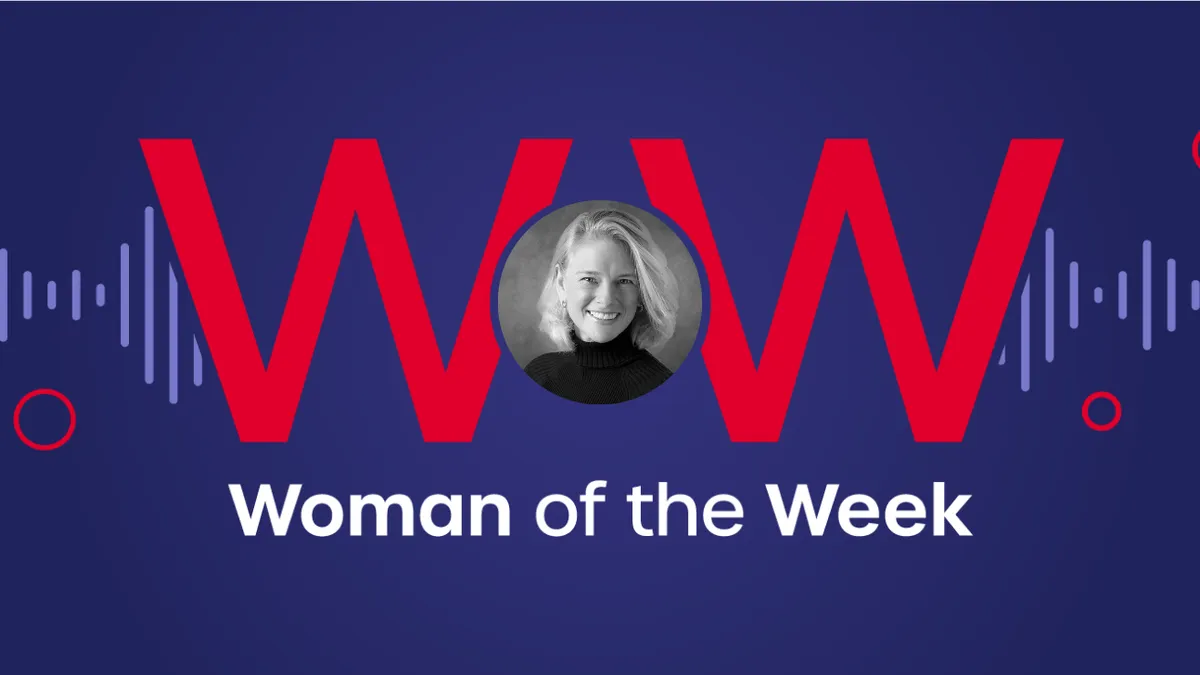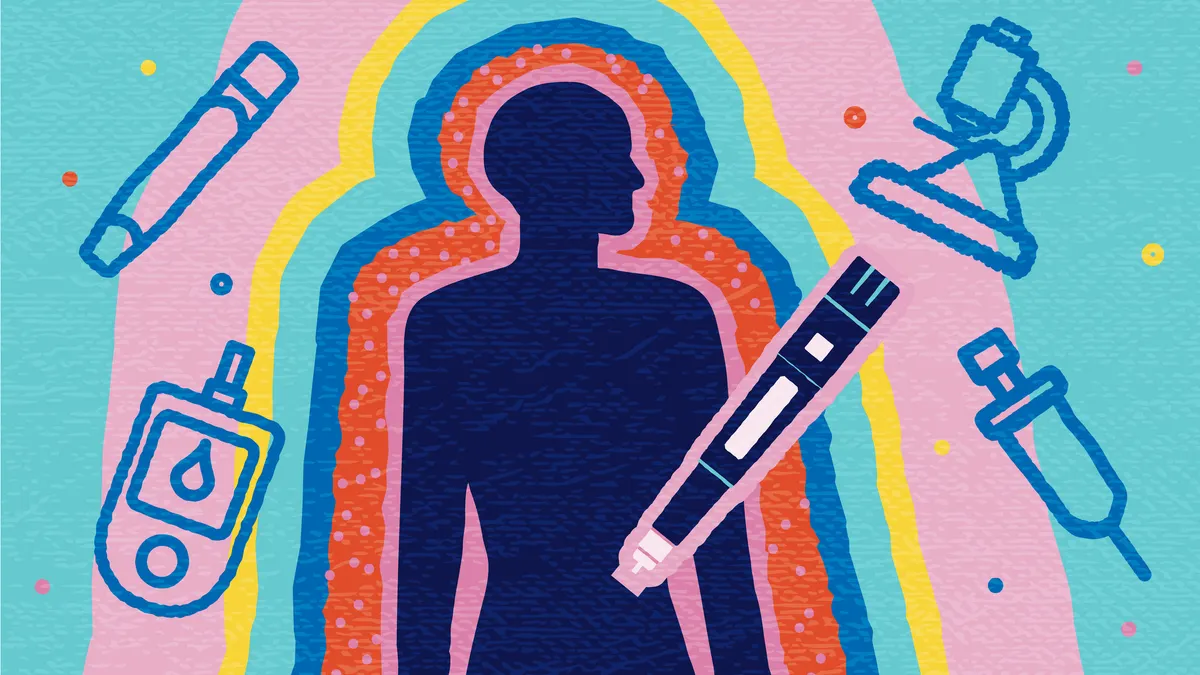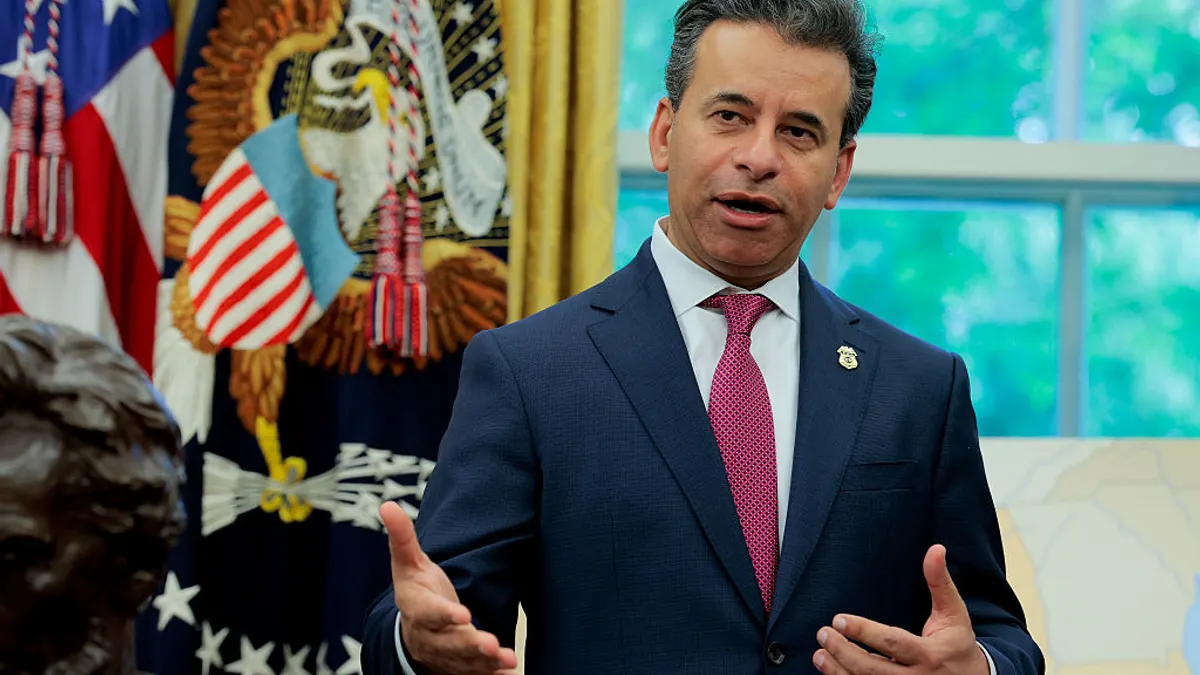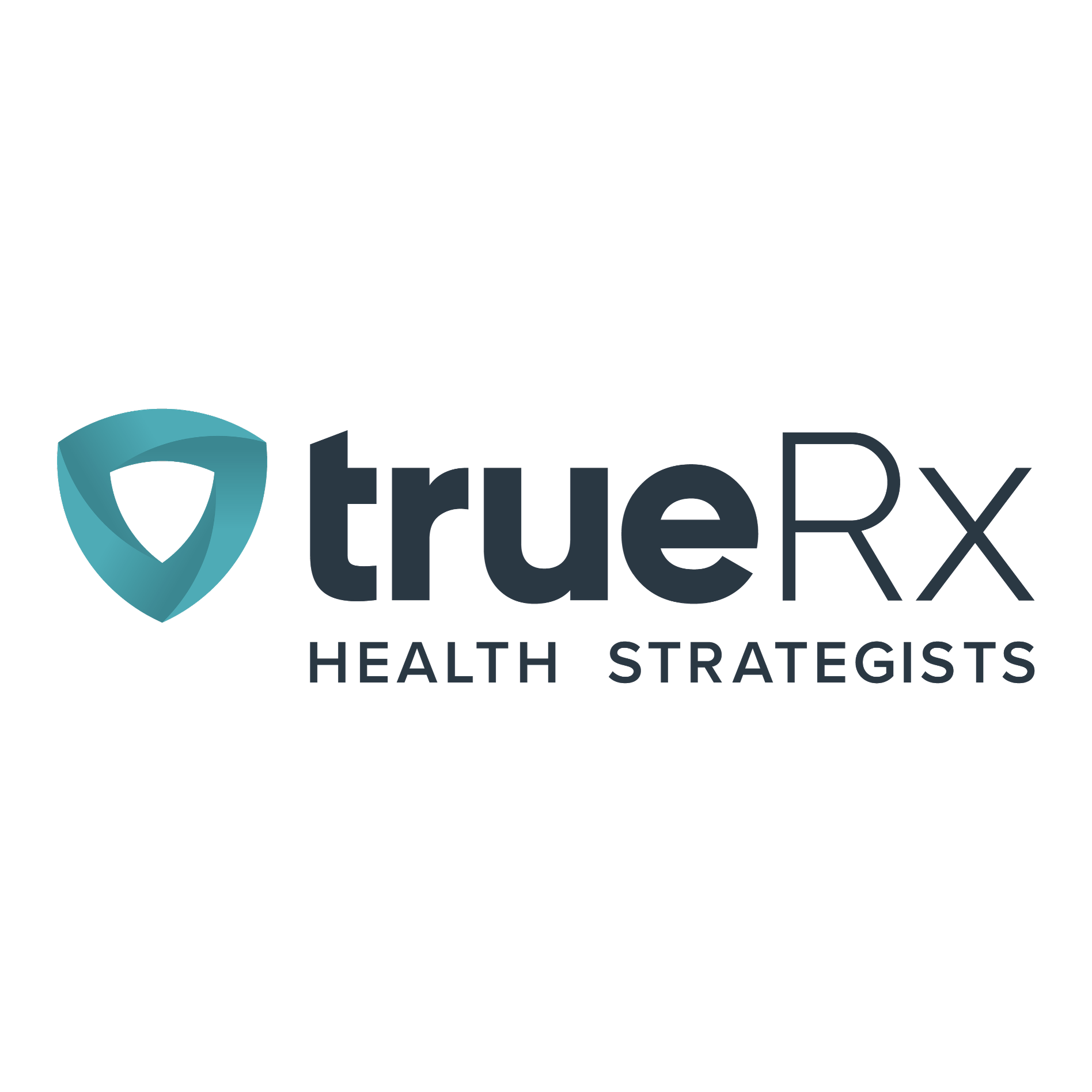Welcome to the Woman of the Week podcast, a weekly discussion that illuminates the unique stories of women leaders who are catalyzing change throughout the life-sciences industry. You can check out all our podcast episodes here.
Dr. Sylvie Laquerre, vice president, disease area leader, solid tumor targeted therapies at the Janssen unit of Johnson & Johnson, is responsible for the strategic direction and execution of the company's solid tumor targeted therapies discovery portfolio. As one of five disease-area stronghold leaders at the company, she guides drug development from target validation to clinical proof-of-concept.
A scientist by training, Laquerre has made it her mission to turn research into reality and bring a new treatment to market for lung cancer — the leading cancer killer of men and women in the U.S. Here, she discusses the complexities of lung cancer, Janssen’s plans for tackling the disease and other underserved cancers, and what it's like for a major pharma division to forge ahead into a new treatment space.
Listen to the podcast or you can also read the transcript of the conversation below.
Editor's note: This show was produced and edited by Dan Limbach.
Interview transcript
Welcome to WoW – the Woman of the Week podcast by PharmaVOICE powered by Industry Dive.
In this episode, Taren Grom, Editor-in-Chief Emeritus at PharmaVOICE, visits with Sylvie Laquerre, Ph.D., Vice President, Disease Area Stronghold Leader, Solid Tumor Targeted Therapy, Janssen Research & Development.
TG: Dr. Laquerre, welcome to the WoW podcast program.
SL: Thank you so much. I’m glad to be here.
TG: Sylvie, tell me a little bit about your journey and the steps that led you to your current role.
SL: I think the first thing that I always have to do is to specify where the accent is coming from, because people have a tendency to try to figure it out and don’t listen to what I say. So the accent is French Canadian. I’m from Quebec City. So in fact, it’s a very cold town apparently for very warm people. I did all my undergrad and my graduate program at Laval University in Quebec City. And I did that in biochemistry, molecular biology and cell biology. Then I went to do a postdoc in the United States. So I thought I would be here for a couple of years and 30 years later, I’m still here. So I guess I like it a little warmer.
And then I was recruited by a company, my first job, in a biotech company in California. Then I was there for a couple of years and to make a long story short, my parents got a little older, wanted to get back on the East Coast. So I came back to Pennsylvania and I’ve been here since then. I’ve worked for a couple of companies and then did the big jump and went to a big pharma – GSK. And then I was there for 10 years and then in 2013, I joined Janssen or J&J. And at the time, I was the discovery lead for the lung cancer disease area stronghold. And I’m going to say that quite a bit today – disease area stronghold. So we’re going to go with the abbreviation of DAS.
Last year, I had the opportunity to become the lead of the solid tumor targeted therapy DAS. Opportunity I could not pass. And since then, with my new role now, I’m responsible to lead the strategy and the execution of the solid tumor targeted therapy group at Janssen. So that means that I’m responsible from target validation to proof of concept in the clinic. All of that, obviously it’s to produce better medicine and more medicine for patients.
TG: Wow. Now I would have said that is definitely a Philadelphia accent. I would never have guessed. Quebec City is one of my favorite, favorite cities and very cold. So I agree with you there. So talk to me about the concept of this disease area stronghold and why this came about at Janssen?
SL: Well, at Janssen we don’t try to work on all the different cancer. We really focus in an area where we can have better expertise that we call disease area stronghold (or DAS). And then when I joined, it was just the beginning of the lung DAS, and I’m really proud that we decided to focus on lung cancer. And it’s because there’s a very big a medical need for lung cancer.
Let me give you a couple of numbers to really frame to you what lung cancer means. There is 2.1 million cases of lung cancer that are diagnosed every year. Fifty percent of those patients will have metastasis at the time of the diagnosis and 1.8 million deaths per year of lung cancer. That mean in a lifetime, people have one chance out of 16 to be diagnosed with lung cancer. One probability I should say. So it’s a very common disease and there’s not a lot of treatment options. So I’m very proud that we’re focusing on lung cancer, and especially that lung cancer often has a bad reputation. This is the cancer of the smoker. Just stop smoking. Well, 20 percent of lung cancer are never smoker. And it’s not due to second-hand smoking that counts only for 1 percent. So clearly cancer that has a lot of impact on people’s life and also, with very little options for the patient in terms of treatment.
TG: I guess that number is surprising and not surprising, considering the function that the lungs perform in our human body, right? Breathing in and out, environmental issues, et cetera. So I do agree, I think it has a bad rep, it’s the smoker disease. I know that you said Janssen wants to focus on those areas that it can impact. So why has there been a dearth of treatments for lung cancer? What’s happening in that space? And how your efforts filling that space?
SL: Well, I think that I need to tell you a little bit more about lung cancer to really grasp this approach of lung cancer. So 85 percent, no. There’s a lot of different type of lung cancer, 85 percent are from a class that we call non-small cell lung cancer. In this non-small cell lung cancer, 50 percent of the patient present with the mutation that we understand that is driving the cancer and there’s drugs that are designed against it. The other 50 percent, the only option is chemo. So clearly, there is a need to understand better lung cancer.
One of the driver mutation of lung cancer is from the epidermal growth factor receptor or EGFR. And when this protein is mutated, then it drives the cancer to divide non-stop. So there’s drug now that exists against lung cancer and they’re called tyrosine kinase inhibitor. And they’re going after those EGFR receptor. So for us to really go after lung cancer, we went into the path of looking at the mechanism of resistance. Because when we think of cancer, we always say it’s not if the resistance will occur, but when it will occur. It will always occur. So patients take treatment and they get a resistance. The resistance that a lot of the EGFR inhibitor are causing, it’s an upregulation in a protein that it’s called c-MET. So now I’m going to stop about all the details.
When I joined Janssen, they had developed a bispecific antibody targeting those two big driver pathway – EGFR and c-MET. So I’ll refer to that as the bispecific. Its name is amivantamab and now that it’s approved, it’s called Rybrevant. So that’s a full pedigree for one drug, but it’s a very good drug. So this is a drug that now is approved and it’s been approved in the different type of EGFR mutation, which is called exon 20 insertion. So amivantamab or Rybrevant is really a cornerstone of our lung franchise. And then we’re developing it in combination in earlier disease and we’re also going in different indication.
So that’s a little bit how we corner our lung cancer franchise, but we’re not stopping there. Because we are really trying to expand, as I said, in different indication. So that’s where we’re called now solid tumor targeted therapy. So the lung DAS shed is lung DAS name, and now we’re ST3 DAS. And then we’re going after different indication.
In fact, from the ST3 DAS was born the bladder DAS. And this is because we followed the science. I’m really proud that we have focused area. And one of the first compound that we put in the clinic was a compound that was against the FGFR pathway. And then when we were doing the clinical trial, we noticed that patient that had bladder cancer were responding very well to this drug. So we follow the science. We start enrolling more and more patients with bladder cancer, and now this drug Balversa is approved for bladder cancer.
While we start with the intent of curing one disease, we cure another one, and then we were successful and then we acquired a company that has a device that can deliver directly the drug into the bladder. And based on that, we form a new DAS. So I’m very optimistic that in the next couple of years maybe there will be new DAS that are going to be born from ST3, who knows?
TG: That’s fascinating it. How exciting and what a great way as you said, to follow the science. To find another drug for another cancer. But let’s talk about amivantamab.
SL: We call it ami for the good friends, much easier to say.
TG: Apparently I can’t get my tongue wrapped around that word. That was a homegrown bispecific antibody, right? And so, how did you turn that research into reality? That had to be an exciting journey for finding that compound and then seeing it turn into reality.
SL: Yeah, you know, I’m a bit different than the other leader at Janssen. I’m coming from a PhD background, most of my colleagues as an MD. And by the way, there’s something that I didn’t say at the beginning. We have five disease area stronghold at Janssen and two of them are led by women. So I’m very proud of Janssen to really give the opportunity for women to lead those big area of oncology research. So when I joined the company as the discovery lead, the goal was to bring amivantamab or ami into the clinic. But there was other compound that were very similar to ami that had failed in the clinic before. So there was kind of a little hesitation of pushing ami very fast into the clinic. In addition, we had other drugs that were ever ready to be tested in the clinic.
So ami took kind of a backseat for a couple of years, but the discovery team that I was leading at the time, we didn’t stop it. We kept generating data and more I was generating data. More I was saying like, I never saw anything as good as that in 30 years of research. But we kept generating data and we were very transparent. We share also the bad data. So we really gain credibility. So we were really perseverant, but we were not zealot. I always say you can deny a hypothesis, but you cannot deny data.
Again, Janssen followed the science. So we had enough good data to bring the compound in the clinic and the rest is history. Now, it’s an approved drug. It’s in a cornerstone of our lung DAS area.
TG: Excellent. And you are talking about some other drugs in the pipeline. So talk to me about what’s coming down the pipe, if you will?
SL: I think that in the next, I would say 24 months, what we’re trying to do with ami. I’m going to start with ami and then maybe give you a general view of what I think is going to happen in oncology.
With ami, I think that the goal is to combine that with other medicine. A bit the same way that we cure HIV, it’s combining drug, and I think that we pretty much are convinced now that the way that we’re going to cure cancer is combining drugs together also. By the way, ami is kind of three drugs all together in one. So it’s already a nice combo, just with one agent. Then we’re combining that with other agent to really corner the cancer, so, there’s no way around.
We’re also trying to go in earlier in the disease. So when you diagnose the patient earlier and you go earlier in the journey of the patient, we have higher probability of success because the cancer has less evolved. However, in order to do that, we need the drug to be relatively safe because the patient has less risk. And then the other part we’re doing with amivantamab it’s to really explore other indication – gastric cancer, colorectal cancer. So those area where ami can probably might have activity.
In terms of what I see coming in the world of oncology in the next 18 months, and it’s really easy to predict 18 months, because 18 months it’s quite short in R&D. So I would say, probably a lot of immuno-oncology it’s been exploding recently and it’s going to continue to do that. More and more combination companies working together to put the best drug together for the patient, which is very refreshing. And also probably, a lot of cell therapy. Transferring immune cell to the patient and hopefully, they’re going to be easier, less costly, and off-the-shelf instead of having to be engineer every time.
TG: I love it … immuno-oncology, better collaboration between frenemy companies and cell therapy. So that’s exciting stuff. That’s three big areas. Three big trends that will be continuing to track. You said something earlier about one of the things that you think could really make a difference is that earlier detection, and that seems to still be a pretty big gap in the market. So how can that be bridge, so that folks who may have lung cancer and may not know it, how can we get to earlier detection for better survival rate?
SL: Yeah. A couple of years ago, it was approved that smoker could have access to radiology to detect cancer and those testing would be free every six months. The problem is that a lot of the things that are detected will resort by itself. So we need to follow the patient. So that way, we can detect early and then the genomic is much, much better now. And then we now have also blood test that we can detect cancer much earlier. So all of that is really important also for us. We’re trying to do the cancer interception. So if we can detect cancer before it’s at the metastatic stage, then it’s much easier to treat and the success is much better.
TG: I love that cancer interception and through the blood testing. So it could even be somebody going in for a routine physical to see their physician and they have routine blood draws done and it’s part of the screening process, so we can really get down to that granular level now.
SL: Absolutely. And we’re trying to do that also with bladder cancer to the urine. So we can detect any kind of mutation that can be leading for cancer. We’re not completely there yet, but it’s certainly something that we have great aspiration to be.
TG: And I loved your earlier comment too when you said, we’re going to cure cancer by doing combinations drugs similar to what we did for HIV. That’s certainly optimistic, and I look forward to seeing you do just that. I think that is really great news on the cancer front. And as we look at cancer changing over the years from being this monolithic oncology or cancer category, we’re now looking at cancer, almost as a personalized disease, because in everybody’s body, it’s a little bit different. So all of these drugs, the things you talked about immuno-oncology and cell therapy, we’re really getting to that personalized medicine nirvana that has talked about for about 15 years or so.
SL: Absolutely, and I think that that’s the beauty, right, we’re all a little bit different. So that’s how we get our power to be different, but the cancer is different also, so you’re right. It’s very personalized and we have probably some and, if we have a lot of combination, it might be drug A and C in one patient, A and B or C and D. And that’s what we need to have is to have a nice tool of medicine that we can combine in the patient based on the genetic of the patient.
TG: It’s exciting. And thank you so much for the great research you’re doing in this area. It could give hope to patients in need. So this is really, its great stuff coming down the pipe. So let’s talk about some of the defining moments in your career. Let’s switch task a little bit in research and talked to me about that. You said, you’re not an MD, you’re a PhD, which is kind of unusual going into the oncology drug development space. So what have been some of those highlights for you? Not your wow moment yet, we’re going to wait, but some of those highlights.
SL: Well, I think that some of the highlight, it’s probably that, I think that we respect each other about what we bring to the table. So I really respect my colleagues that have a very good background in medicine and can design clinical trial much better than I can. But also, they look at me and know that I understand the details of the science and the mechanism of action. So instead of trying to do it all, we do what we’re good at and we count on the other one to do what we’re not good at. So I think it’s been a very good journey, but I think there is certainly had some challenges. If I look at the challenge, well, coming to the US without speaking English was certainly my first challenge.
But another challenge, we really want more women in science, no doubt about it. But I have to admit that most in my career, I was the only woman in the room and it’s been a challenge because you don’t have a lot of role models and not a lot of people that look like you. And at the beginning, I was trying kind of be like my male colleague. I thought I needed to be like them to be successful. I fail. And I realized today that I don’t want to be like them nor that I want them to be like me. I think that gender independent, we have to apply what we’re good at. I think we’re perfect the way we are. We just need to focus on what we’re good at. And as I said, let the other one do what you’re not good at and that person doing what you’re not good at is probably not good at something you’re good at. So I think it’s perfect. We just have to recognize it and accept it and sometimes, it’s surprising what people can come up with that you will not have expect if you just let it happen.
TG: It’s the same time and I absolutely agree with that. It’s the same time you really are, though a role model to a lot of other women who are coming up through the sciences, advanced sciences. As you said, there’s not a lot of folks who look like you out there. Although, you said two out of the five leads in this specific area where you’re doing this are women, so that’s great. So there’s a certain amount of responsibility that lies on your shoulders. What does that mean for you to be a guidepost for other women who want to be in your position someday?
SL: Well, I think that sometimes it’s a bit scary. Because, being a role model, you put a lot on your shoulder. But I go back to my basic – just be you and with your vulnerability. And with things that you’re might not going to do well, but accept that you cannot be good at everything and be transparent and honest. So those are the things – those are really the core of who I am. Just admit when you just don’t do it right and then go seek that help. And I think that shape a lot of who I am and who I surround myself with.
But in terms of responsibility, you know, it’s funny. I think it takes a lot of time and effort for a whole world to train someone like people in my position. It takes a lot of training to be a good scientist, to be a good manager, to be a good strategist. And I think I’m pretty good at what I’m doing now. I had it for a long time. So now, it’s time to give back. It’s time to give back to my team. It’s time to give back to the college that helped me, that trained me. It’s time to give back to my boss who believe in me. It’s time to give back to Janssen. It’s time to give back to the patient. It’s time to give back to the society. So sometimes when I think that it’s too hard and I’m tired and I want to hang my hat and say, I’m done. I’m saying, “no way. Come on Sylvie buckle up,” and discover another couple of drugs before you call it a go. So I really owe it to the society and I mean it. I feel I owe it. I’m so privileged to be in that position that now it’s time to pay back.
TG: I love that, Sylvie. I think you got more in gas in your tank too. So I love how you keep going. So let’s talk about giving back a little bit in terms of well, will ask you about your mentors in just a minute and folks who helped you along the way. But I want to talk to you about how you build those high performing teams? Because obviously, drug development is hard. It’s fraught with disappointments and great successes. So how do you balance all that out? What are those key characteristics you look for when you’re trying to build out a team?
SL: Well, like I said, I think what is important for me is transparency and respect. I think if you start with that you have very good foundation. So I tend to look at people that behave this way. I think knowledge is very important. So it’s technical what we’re doing. So we need people that know what they’re doing. But I think it’s what is the most important is this, I can attitude. It’s hard what we’re doing. Most of the team, people are doing it. They are the first one in the world to do it. That’s the experiment and nobody did it before. And sometimes the reagents are not there. The samples are not there. The time is not there. It’s costly and I don’t do too well with that. I like people that are going to roll their sleeve and say, “I can. I will give it everything I can and I’ll give it a try.” And most of the time, we maybe not reached the 100 percent, but sometimes we can draw conclusion to 80 percent that help us to go to the next step.
So the, I can do attitude is a must to be in my team.
TG: I love that. I can do, yes, you can do. I can see that clearly that you are a doer. So we talked about sometimes being the only woman in the room. Throughout your career, if you had some folks who have been mentors or sponsors for you to help progress your career?
SL: Oh yeah. I think that I had a mentor. However, there was not a lot of role model as I told you. There’s a lot of people that helped me and a lot of people that believe in me. I’m very thankful for all those people that I encounter along the way that gave me the chance to do what I love to do and to do it at a higher level. However, I have a tendency to model myself to anybody that is successful, independent of who that person is. I’m trying to be a little bit of a chameleon of trying to mimic what they’re doing, just because I know that they’re good at something and maybe I can try that. Sometimes it doesn’t work for me, but I give it a try. So maybe I have a lot of mentors that they just don’t know about yet.
TG: So it’s funny. I was talking to somebody the other day and they talked about situational mentorship. So exactly to that point where they identified somebody who is a great speaker and they needed help on their presentation skills. So they asked them for 30 minutes of their time and said ‘you know, everybody’s got 30 minutes to give.’ It’s not that you’re looking for a lifetime commitment to be a mentor. So I love that concept. Throughout your career, is there any piece of leadership advice that you hang your hat on today and say, “you know what, that was really key for me. Somebody told me something that’s really meant something to me throughout my career,” and then I’ll ask you, what is the best piece of leadership advice you provide to others?
SL: I think the best advice I got in my career in terms of leadership is listen. I’m not very good at it, but I’m practicing every day. But I’m just amazed that if I can tolerate this two, three or 10 seconds of silence, which is really hard for me. But if I can tolerate that, what comes out of it is just amazing. It’s not all the time the faster thinker that are the brighter. So we have to give the time to the people that needs a little bit of time to get you the answer that you might need. And every time I do it and I tried to do it every day, I have a recorded that I put it down that I did it today or discipline is my middle name, by the way. So I put it down and I make sure that I’ve done it today, but amazing thing happened when you do that. So I will give it to everybody. I would say, don’t do like me, but listen to me.
TG: They say that’s why God gave you two ears and only one mouth.
SL: That’s a good one.
TG: Use them both the right way. I love that discipline is your middle name. Do you find yourself to also being called on to be a mentor now? And how does that work for you?
SL: That happened. It’s funny because I reserve Friday on my schedule for that. So I book like three or four hours just to mentor. And I let people give me a 30-minute call and we talked about it. It can go in all sort of direction. I have this woman that calls me from China at 10 o’clock a.m. my time, so it’s 10 o’clock p.m. her time on Friday for mentorship. So I’m thinking wow, she really values that on the Friday night at 10 o’clock, but it’s fun. I just do it like it’s a nice conversation and sometimes I bounce things through her, you know, when it was COVID in Asia, she is leading this team, so I needed to catch up with her. And it was just some time it’s just me, who’s mentored by her more than her mentored by me. It goes both ways.
TG: And that’s the beauty of a good mentoring relationship is that it should be that 2-way exchange. So that’s fantastic. I’m so sorry to have our conversation come to an end. But I’m at my last question for you. And that is, tell me about an accomplishment or a wow moment that either shaped your career or change the trajectory of your career?
SL: I can remember like it was yesterday. I think what was the most important moment of my career, it’s when I listen for the first time a patient testimony on the benefit of a drug that I work on. This is even like just a thought about it, I get all choked up again. This is really transformational. This is a game changer that you can or you have the gift that you can influence somebody’s life. This is an addition of being fantastic, this is addictive. When you do it once you want to do it again. First, you want to do it again because you want to make sure that it was not like at the right place at the right time. You want to make sure that you were part of that. And after you do it a couple of times, then you say, “okay, I can do it and I’m going to do it again.”
So it’s completely addictive. But the irony of all of that I think, is that I didn’t want to go in medicine because I didn’t want to deal with people’s problem. I didn’t want to deal with what was going on in their personal life. I wanted to fix the problem at the molecular level. But full circle now, where I get the most reward is when I fix something at the molecular level, but I get the reward by the emotional connection that I get with the patient. So it’s a full circle and isn’t it amazing how life can always throw you like, a curveball that you’re not expecting. But the beauty of it is that, if you’re spontaneous maybe we can hit a home run, those curveballs.
TG: Well, yes, you can hit a home run after a curveball, for sure. And it’s not being spontaneous, but also being open to the opportunity that presents itself, right? So you said your middle name was discipline. I think your middle name is, can do. Your optimism is infectious. I am so excited to see what the future of oncology in the lung space hold, because it is certainly underserved right now. And I can’t thank you enough for what you do. On behalf of patients, it’s been a delight to speak with you. Thank you so much for being part of our Wow podcast program. And I want to wish you continued success and let’s stay in touch.
SL: Well, it was a pleasure. Thank you so much for having me. It’s an honor and continue doing what you’re doing. We have a lot of women to influence; so, thank you so much to you and your team.
Thanks for listening to this episode of Wow – the Woman of the Week podcast. For more Wow episodes, visit pharmavoice.com.


 Podcast
Podcast


















